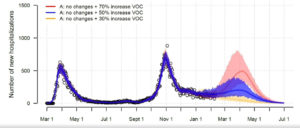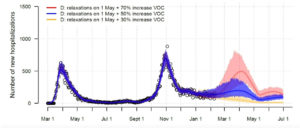During a press conference on Monday, biostatistician Niel Hens presented four different long-term models, which will form the basis for the Consultative Committee's decisions next Friday.
For each of the four scenarios, there are three different curves, in three different colours.
The red colour assumes that the British coronavirus variant is 70% more infectious, the blue curve assumes 50%, the yellow colour assumes a greater transmission rate of 30%.
"There is still a lot of uncertainty there. Hence the different curves," Hens said. The most likely scenario, however, would be around 50%, according to him.
"This means that if, in general, a person infected one other person with the previous variant, they would now infect 1.5 persons with the British variant," he said.
In the first scenario, the measures remain as they are at the moment: no rules are relaxed, and no new measures are introduced.

Model A: nothing changes. Credit: Youtube screengrab
“According to the blue curve, we might expect a flare-up in this scenario, but that is a big uncertainty," said Hens. "That uncertainty is very important. That feels very uncomfortable, we know."
In the second model, the measures are relaxed on 1 March. The third scenario shows what could happen if the measures are relaxed on 1 April. Lastly, in the fourth scenario, the measures are not relaxed until 1 May.
Especially the second model - in which relaxations would happen from 1 March - looks "dramatic," according to Hens.

Model B: relaxations from 1 March. Credit: Youtube screengrab
“In this scenario, we see a relaxation of the measures, or a return to the contact behaviour of the month of September. Remember that September was a month in which a lot was possible," he said.
"On the yellow curve, the easing has little effect. But looking at the blue curve, we see an increase that looks very similar to the second wave that we experienced. This curve is notably wider, which would translate into a bigger burden on the hospitals."
The peak of the red curve - where the British variant is assumed to be 70% more infectious - is almost double that of the peak of the second wave.
In the third scenario, the experts took into account the same relaxation, not on 1 March but on 1 April. "There you can already see a big difference, and that is largely due to the vaccination strategy," Hens said.

Model C: relaxations from 1 April. Credit: Youtube screengrab
The fourth scenario illustrates what is likely to happen when the measures will be relaxed from 1 May. "What you see is that we can more or less keep it under control, and the rise that would follow after the relaxation is limited. It is there, but it remains limited," Hens said.
“The same is true as in April, but even more so. A higher level of infectivity would then also remain manageable," he added.

Model D: relaxations from 1 May. Credit: Youtube screengrab
When the scenarios were drawn up, the expected progress of the vaccination campaign was taken into account, but a possible seasonal effect was not.
"This is because the figures there are very wide-ranging. There could be a positive effect, but unfortunately, it will not outweigh the infectiousness of the British variant."
Additionally, the possibility that the British variant could lead to more hospitalisations and deaths was not taken into account, not was the possible impact of travel.
Related News
- Belgium announces long-term models to handle pandemic
- Belgium will review curfew and non-essential travel ban on Friday
Following the presentation of the models, Belgium's Prime Minister Alexander De Croo stressed that perspective must be based on facts and science.
“We are approaching the point where the risk of a third wave seriously diminishes. Is that point tomorrow or next week? I think the presentations show that it is not,” he said. “But that point is also no longer very far away.”
"Perspective based on opinions alone is based on quicksand, and has little value,” De Croo said. “It is up to the Consultative Committee on Friday to make the decisions. In my view, it is important, that we base ourselves on scientific facts.”
Maïthé Chini
The Brussels Times

